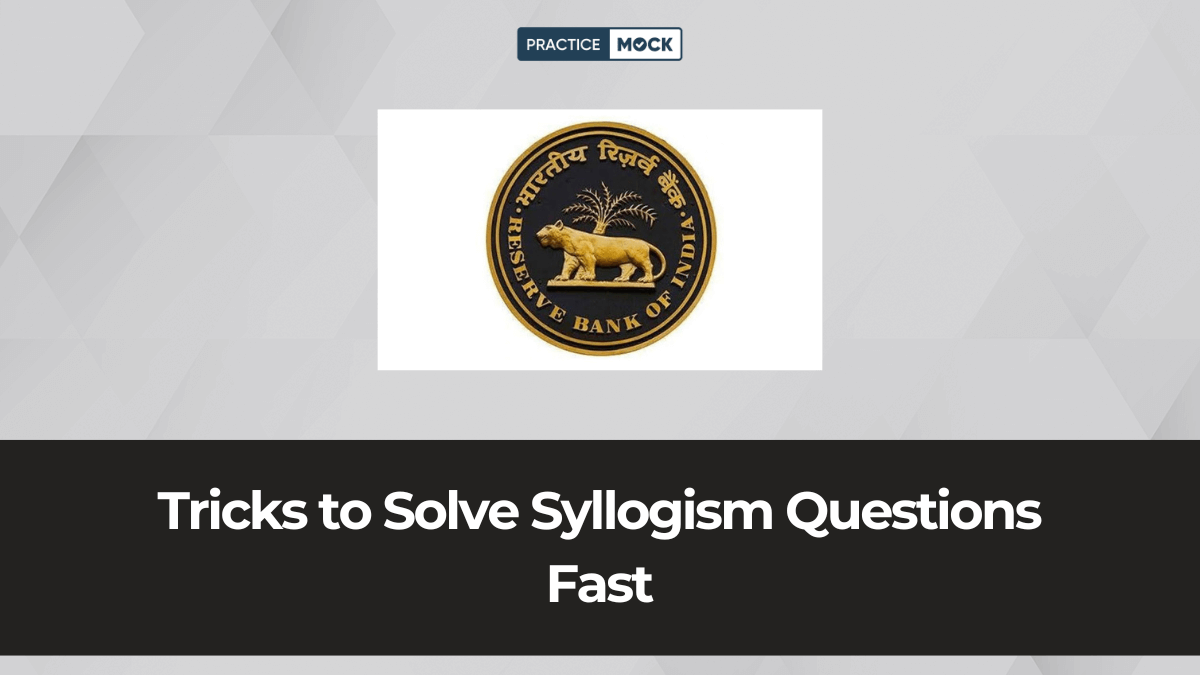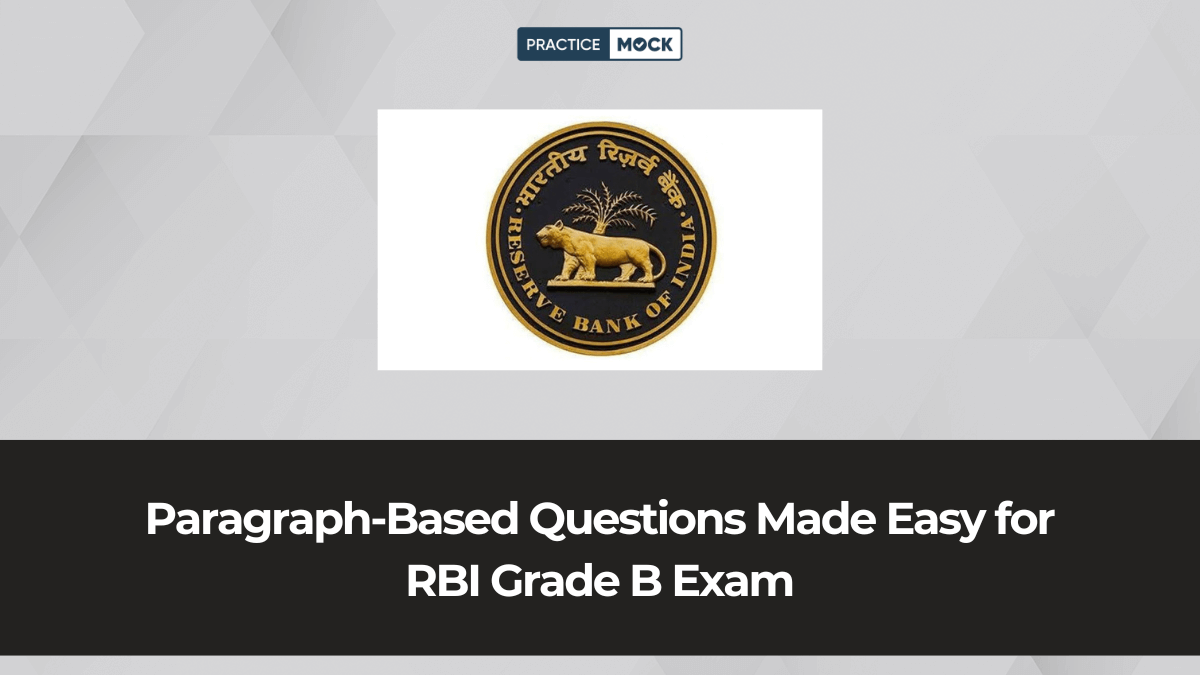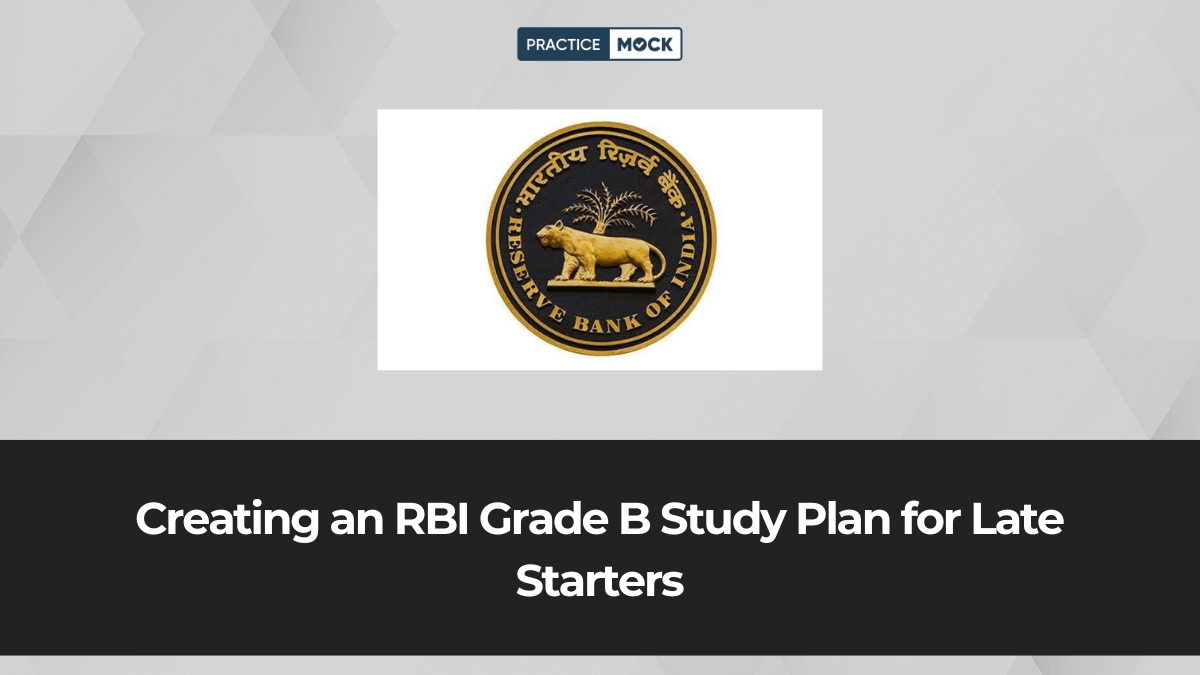Top Tips to Solve Syllogism Questions Fast


Syllogism is an important topic in the Reasoning Ability section of the RBI Grade B Phase 1 exam. This topic typically carries 3–5 marks and is a regular feature in the exam every year. It tests your ability to draw logical conclusions based on given statements. These questions may seem easy, but they often include twisty statements. They have confusing logic that is designed to confuse you, if you’re not careful. Therefore, mastering Syllogism is essential if you want to maximize your overall score in the Reasoning section. And the good part is that you can solve these questions quickly and accurately. But only with the right techniques and regular practice. In this blog, we’ll share simple and smart tips to help you improve your speed and accuracy in Syllogism. Plus, you’ll also find sample questions with solutions to fine-tune your preparation.
Best Tricks to Solve Syllogism Questions Quickly
Syllogism tests a candidate’s ability to logically deduce conclusions from given statements. Syllogism questions look easy at first glance. But they can be tricky if not solved in the right way. So, many candidates get confused between “some”, “all”, “no” or “some not” type statements. That’s where practice and strategy come in. Here are the best tips that, if you follow, can help you master the strategy to solve all types of syllogism questions smartly:
1. Understand the Keywords Clearly
Syllogism questions depend on logic. And logic depends on understanding each keyword properly. Don’t mix up “some”, “some not”, “all” and “no”.
Here’s what to keep in mind:
- “All A are B” means every A is inside B.
- “Some A are B” means at least one A is B.
- “No A is B” means A and B are completely separate.
- “Some A are not B” means at least one A is outside B.
- Knowing the exact meaning avoids silly mistakes.
2. Use Venn Diagrams to Visualize
Never try to solve Syllogism questions in your head. The best way is to draw Venn diagrams and see the relationships visually.
Here are some tips:
- Use circles to represent each group or term.
- Overlap only when required.
- Don’t force overlap if not mentioned.
- Try drawing all possible diagrams if needed.
- This method works best with “possibility” type questions.
3. Practice Reverse Checking for Conclusions
Sometimes, the conclusion seems true at first, but it’s not always valid. Try checking the conclusion with all possible diagrams.
Let’s see how:
- If a conclusion is true in all possible cases, it’s valid.
- If even one diagram shows it false, it’s invalid.
- For possibility questions, check if it’s possible, not definite.
- This technique avoids getting tricked by half-true statements.
4. Focus on Common Patterns and Shortcuts
Most questions follow a few standard patterns. Learn those and solve questions faster.
Try this:
- “All + All = All”
- “All + No = No”
- “Some + All = No Conclusion”
- Learn these patterns by heart.
- Use them to eliminate wrong options quickly.
5. Practice Timed Sets Regularly
Speed is key in the exam. Build your habit of solving each question in under 1 minute.
Here’s how:
- Use a timer during practice.
- Track your accuracy and timing.
- Practice both basic and tricky cases.
- Take mock tests to build real exam stamina.
Also, go through the 60 days Study Plan for the RBI Grade B Exam 2025
Sample Syllogism Questions for Practice
Given below are some of the most important questions with solutions that will help you better understand syllogism questions and how to face them:
Question 1: In the question below some statements are given two conclusions followed by some statements. You have to take the given statements to be true even if they seem to be at variance with commonly known facts. Read the conclusions and then decide which of the following statement is true for given conclusions.
Conclusions:
I. No Rainy are Summer
II. Some Summer being Autumn is a possibility
Statements:
A) No Spring are Rainy. 100% Rainy are Winter. 100% Autumn are Winter. No Winter are Summer.
B) All Rainy are Winter. No Rainy are Spring. A few Summer are Autumn. All Autumn are Winter.
C) Some Winter are Rainy. Only Winter are Summer. Only a few Rainy are Autumn. All Spring are Autumn.
D) Only Winter are Rainy. Only a few Autumn are Winter. No Winter are Summer. Only a few Summer are Spring.
E) None of the above
Solution:
Now, by drawing the Venn diagram we get:
Statement (a):
I. No Rainy are Summer follows.
II. Some Summer being Autumn is a possibility doesn’t follow.
Statement (b):
I. No Rainy are Summer doesn’t follow.
II. Some Summer being Autumn is a possibility doesn’t follow.
Statement (c):
I. No Rainy are Summer follows.
II. Some Summer being Autumn is a possibility doesn’t follow.
Statement (d):
I. No Rainy are Summer follows.
II. Some Summer being Autumn is a possibility follow.
Statement (d) will make both the conclusions definitely follow.
Hence, option d.
Question 2: In the question below there are three conclusions followed by four statements in the options. You have to take the four given statements to be true even if they seem to be at variance from commonly known facts and then decide which of the given statements are true disregarding the commonly known facts.
Conclusions:
No round is square.
Some square are not parallel.
Some circle are round.
Statements:
A) Some circle are square. Some rectangle are square. Some rectangle are parallel. Some circle are round.
B) All circle are round. All circle are square. Some rectangle are square. All rectangle are parallel.
C) All circle are square. Some circle are round. Some rectangle are square. No rectangle is parallel.
D) Only circle are round. Some circle are square. Some rectangle are square. No rectangle is parallel.
E) None of the above
Solution:
The following figures can be formed:
From the figures, only the statements given in option (d) are true.
Hence, option d.
Question 3: In the question below there are three conclusions followed by four statements in the options. You have to take the four given statements to be true even if they seem to be at variance from commonly known facts and then decide which of the given statements are true, disregarding the commonly known facts.
Conclusions:
Some five are not nine.
Some seven are eight.
Some six are not eight.
Statements:
A) No nine is eight. Some eight are five. Some five are seven. All six are nine.
B) Some six are nine. No nine is eight. Some eight are five. All five are seven.
C) Some six are nine. Some nine are eight. Some eight are five. Some five are seven.
D) Some five are seven. Some six are nine. All nine are eight. Some eight are five.
E) None of the above
Solution:
Following figures can be formed:
From the figures, only the statements given in option (b) are true.
Hence, option b.
Question 4: In the given question, two columns are given such that column I has three sets of statements while column II has three sets of conclusions. You have to assume the given statement to be true even if they seem to be at variance from commonly known facts. Match the conclusions S, T and U which will logically follow the statement P, Q and R disregarding the commonly known facts.
(A statement is said to be followed if both the conclusions given against the statement S, T and U are true according to the statements P, Q and R)
| Column I | Column II |
| P. Only City are Metro. No City are Bus. All Train are Bus. | S. All Train can be Metro. Some City are not Metro is a possibility. |
| Q. Only a few Metro are City. All City are Bus. No Bus are Train. | T. Some Metro are Train is a possibility. Some Bus are Train is a possibility. |
| R. Only a few Bus are City. Only a few City is Train. Only a few Metro areTrain. | U. Some Train can never be City. No Bus are Metro. |
A) PT and RU
B) RT and RS
C) RS and PU
D) RT and TU
E) PU and QU
Solution:
P.) Only City are Metro. No City are Bus. All Train are Bus.
So, following figure can be formed from the statement:
S. All Train can be Metro is definitely false. Some City are not Metro is a possibility is definitely false.
T. Some Metro are Train is a possibility is definitely false. Some Bus are Train is a possibility is definitely false.
U. Some Train can never be City is definitely true. No Bus are Metro is definitely true.
So, U follows from P.
Q). Only a few Metro are City. All City are Bus. No Bus are Train.
Following figure can be formed from the statements:
S. All Train can be Metro is definitely true. Some City are not Metro is a possibility is not definitely true.
T. Some Metro are Train is a possibility is definitely true. Some Bus are Train is a possibility is definitely false.
U. Some Train can never be City is definitely true. No Bus are Metro is definitely false.
So, U doesn’t follow from Q.
R.) Only a few Bus are City. Only a few City is Train. Only a few Metro are Train.
Following figure can be formed from the statements:
S.All Train can be Metro is definitely true. Some City are not Metro is a possibility is definitely true.
T. Some Metro are Train is a possibility is definitely false. Some Bus are Train is a possibility is definitely true.
U. Some Train can never be City is definitely false. No Bus are Metro is definitely false.
So, S follows from R.
Hence, option c.
Question 5: In the question below some statements are given two conclusions followed by some statements. You have to take the given statements to be true even if they seem to be at variance with commonly known facts. Read the conclusions and then decide which of the following statement is true for given conclusions.
Conclusions:
I. No Friends are Love
II. Some Hate are not Care
Statements:
A) All Love are Hate. Only a few Care are Hate. No Hate are Affection. All Friends are Affection.
B) All Love are Hate. No Friends are Affection. Some Affection are Hate. Only Hate are Care.
C) All Hate are Friends. Some Hate are Care. Only Care are Affection. No Love are Care.
D) All Friends are Hate. Every Hate are Affection. Only Affection are Love. No Affection are Care.
E) None of the above
Solution:
Now, by drawing the Venn diagram we get:
Statement (a):
I. No Friends are Love follows.
II. Some Hate are not Care doesn’t follow.
Statement (b):
I. No Friends are Love definitely doesn’t follow.
II. Some Hate are not Care follows.
Statement (c):
I. No Friends are Love doesn’t follow.
II. Some Hate are not Care doesn’t follow.
Statement (d):
I. No Friends are Love follows.
II. Some Hate are not Care follows.
Statement (d) will make both the conclusions definitely follow.
Hence, option d.
Takeaway
Syllogism questions become easy with regular practice and clear strategies. Master the keywords, draw accurate Venn diagrams, and revise logic patterns often. Stay consistent and keep testing yourself. Want to improve your score in Reasoning? Start today with PracticeMock’s Free RBI Grade B Mock Test and explore our expert resources designed to boost your prep from day one.
Join our unique Telegram group immediately to skyrocket your preparation for Regulatory exams via expert guidance, top tips, perfect feedback, and much more!
[ Click Here to join the PracticeMock Telegram Group! ]
[ Click Here to join the PracticeMock Telegram Discussion Group Link! ]
Related Posts:
FAQs
Use Venn diagrams and check each conclusion logically.
Aim to solve each question in under 1 minute.
Yes, they are a regular part of the Reasoning section.
Use reverse logic and test conclusions against all diagrams.
Mocks help, but combine them with concept learning and revision.
Recent Posts
Paragraph-Based Questions Made Easy for RBI Grade B Exam
Paragraph-based questions are time and again in the English Language section of Phase 1. Often,…
RBI Grade B Study Plan 2025 For 60 Days, Ultimate Exam Preparation Schedule
Looking to clear RBI Grade B 2025? Follow our 60-day super Schedule for expert tips,…
Success Story of Jasvant Singh Rajpurohit Cleared IBPS PO and Clerk
Read the Success Story of Jasvant Singh Rajpurohit cleared IBPS PO and Clerk, to get…
Paragraph-Based Questions Made Easy for RBI Grade B Exam
Learn how to answer paragraph-based questions easily in RBI Grade B with simple reading tips,…
How to Manage Time During RRB Clerk 2025 Exam Preparation? – Check Tips to Crack The Exam
In this article we have talked about the RRB Clerk Exam Strategy. You can follow…
UCO Bank LBO Result 2025 Out, Check Local Bank Officer Result PDF
The UCO Bank LBO Result 2025 has been released on their official website. Candidates can…



